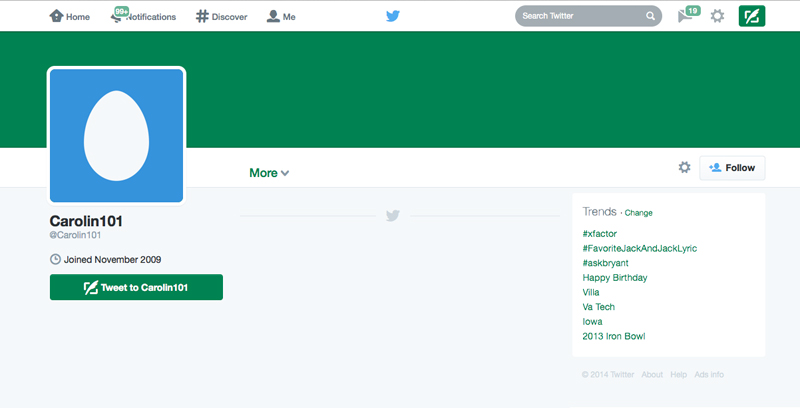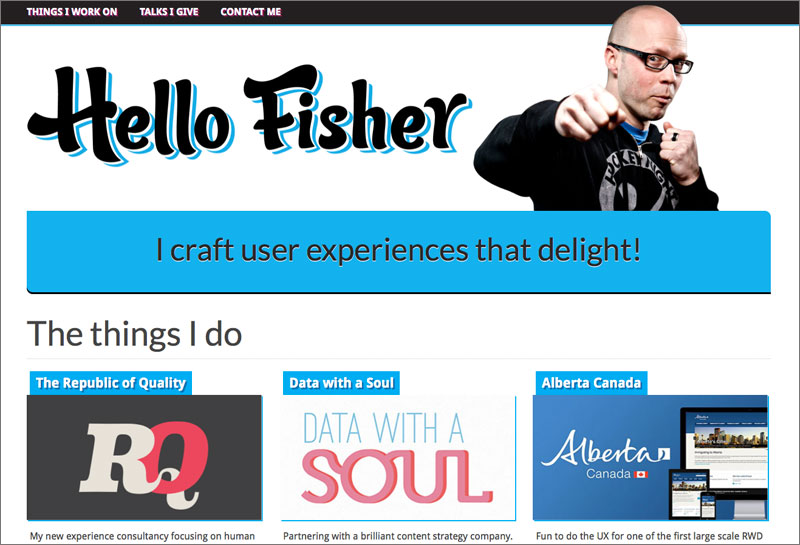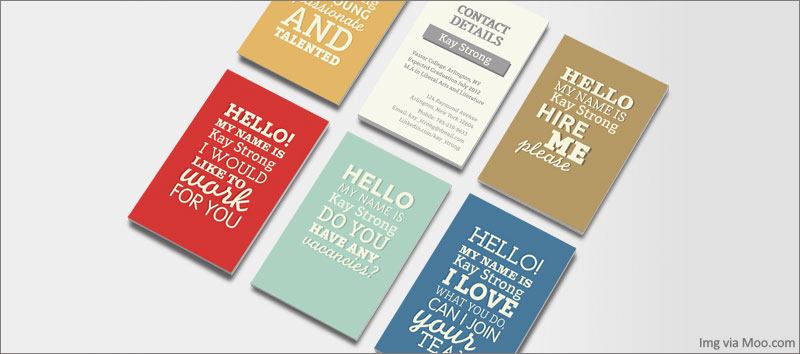Design matters
Whether you consciously think about it or not, design has an influence on the decisions you make every day — the phone you use, shoes you wear, and websites you visit.
Why is it then, that the concept of design still seems to be in the dark ages when it comes to job-hunting?
Many people think that great design is too expensive, but my feeling is that design is an investment.
If you’ve got the knack for it, it’s worth it to take classes and become skilled with the latest software. If it’s not your thing, find a designer that you enjoy working with and that understands your style and build a long-term relationship with them. It will be worth every penny.
Here are 5 overlooked design tips to help you stand out from the pack, land a job, and get paid:
1) Spruce up your resume
Does your Microsoft Word-templated resume have your name and address at the top, a summary of skills, and your work experience in chronological order? Congratulations, so does nearly every other job-seeker going for the same position as you.
If there’s one document that has survived the test of time, it’s the chronological resume. And why not? For the vast majority of people, it’s familiar and it works.
But in a competitive job market, sometimes you need to zig when everyone else is zagging. At minimum, for the love of Times New Roman, do SOMETHING that makes your resume stand out a bit… change the typeface, play with different font sizes, and add a horizontal line or two. Going a little bit further, add some elements of color, reversed text, and even an icon or two.

Taking it to the next level, re-envision the resume and give it a full design makeover. For $99, LoftResumes.com will take your blah resume and make it come alive.
The most radical transformation would be turning your resume into an infographic. You can head over to Cool Infographics.com or do a Google search for cool looking infographic resumes, or head over to a site such as re.vu.
A word to the wise here: Many job boards and in-house screening systems are set up to review hundreds of resumes at a time, using algorithms to scan for matching keywords for open positions. If all you have is a graphic-only resume, you might be passed over.
The solution is simple. Have two versions of your resume. If you’re applying directly online or to a generic email address, go conservative and send your text-only version.
However, you DO know that upwards of 80% of jobs are found through networking, right? When you have a specific connection within a company and are able to email someone directly or leave it with them in person, take the opportunity to set yourself apart.
2) Get a professional headshot photo
When’s the last time you were asked to upload a photo of yourself to the web? Last month? Last week? Today? As the social web has exploded, the number of places that you show your true self has increased as well.
If you’re looking for work, having a professional photo on your LinkedIn profile will give a good first impression to a hiring manager. As you progress in your career, you might be asked for a photo for your company’s website, a conference badge, a story in your college alumni newsletter, or for a bio if you’re speaking on a panel.
But the uses don’t end in the corporate world. Here are just a few sites that ask for a photo: Facebook, Twitter, Meetup, Airbnb, Gmail, Skype, online dating sites, commenting systems, message boards, instant messaging, chat, and the ‘About Me’ section of your blog.
Note: This doesn’t mean that the photo has to be boring. Sure, you’ll want at least one close-up and head-and-shoulders shot while wearing a business-appropriate suit or jacket, but providing a shot that emphasizes your area of expertise and brand can make an impression as well.

- So if you’re a chef? Get a great photo creating your signature dish in a busy kitchen
- Non-profit fundraising manager? Get some shots with those that you love helping
- Yoga instructor? I’m sure you can figure out the best “pose”
Low on cash? At least find a photography-loving friend with a DSLR that can give you something better than your one-handed self-shot from your iPhone. But for a few hundred dollars, investing in a pro that knows proper lighting and composition is worth it.
3) Customize your Twitter background
If you’re active on Twitter and are going to list it on your resume, take a moment to customize the background. Nothing says “I don’t care†more than not making the effort to change the default graphic. If you’re in a full-on job search, go ahead and say so on the page and make it easy for people to contact you.

This goes for your bio as well. I once announced a job opening to my Twitter followers and got a response from someone saying they were interested, but when I clicked through to their profile, the tagline in their bio said “Slacker extraordinaire.†Not a good way to start things out.
4) Create a cool business card
Remember the part about networking? If you’re doing it right, you’ll be meeting lots and lots of people in person. Carrying copies of your resume is a little too forward, and do you really want to rely on someone typing your multi-syllable email address into their smartphone accurately as you shout it into their ear while at a loud party?
Create a business card for yourself, and make it a good one. There are plenty of great sites out there, such as Vistaprint.com, overnightprints.com (my favorite), and Moo Cards. Best of all, the prices start at… FREE.
But once again, you get what you pay for. Sure, you can have a basic white card with black text with your name, email, and phone that doesn’t cost you a thing. But for just a bit more, you can get a full-color, 2-sided, glossy card on thicker stock that will leave an impression.
Put it this way… even if you spent $400 on design and $100 on production to print up 1,000 business cards that said “web developer for hire†and the FIRST card you handed out resulted in a job paying $50,000 a year, would you be upset over the money spent and 999 cards you needed to throw away? I didn’t think so.
5) Create your own website. Today.
The question today isn’t IF a hiring manager will do a Google search on your name (studies report 75% of companies are required to do so), it’s what they will find when they do it. Who wouldn’t want to help control what people see and put their best foot forward?

True story: I was once speaking to a group of students about the importance of owning their own domain name (ie, yourname.com) when job searching. I quoted the stat above, talked about how a good search result could help push down negative results (ie, those beer pong photos from spring break), and the fact that it was very easy and very cheap to do so.
The next day on the classroom chat board, someone posted “Does anyone know of any free places to register your name? All the ones I found require a credit card.â€
Now, I could understand if I had said the following… “Building a website is very important to getting a job, even though it takes about 40 hours of work and costs about $3,000.†I get it, students are poor. Free is better than paid.
But in reality, it takes less than 10 minutes to set up a very simple website, and the cost is about $12. A year. It was very difficult for him to argue that $1 per month was not a good “investment†toward building a brand and increasing the chances of getting hired.
But what stuck with me is that creating a website still seems like a daunting and intimidating task for many people. Don’t let it be. (I ended up recording a step-by-step tutorial to walk them through the process, and it was only 7 minutes).
I won’t get into the entire process here, but will give you a few links to explore.
Options for starting your own website:
- Check out my quick tutorial at Get Your Name Today
- Strikingly.com (check out their 1-click website creator via LinkedIn)
- About.me
- SquareSpace.com
- WordPress.com
- WordPress.org along with themes from Themeforest.net or WooThemes
What if my name is common and someone already has it?
Great question. I went ahead and listed out 7 suggestions if your website name is already taken (and 3 things not to do), such as using another extension (.co or .net) or adding a modifier to your name.
Conclusion
There was a time when you were judged by the college you went to and the grades you received, which were presented on a crisp resume printed on thick ecru-colored paper. And in some locations and some industries, that may still be the case.
But more and more, those that succeed are the people who are able to set themselves apart and prove that they are more than just words on a page, and are able to tell their story in a unique way on paper, in person, and on the web.
Still confused?
I understand, you still have questions.
- What do I wear for my headshot photoshoot?
- How do I set up a blog?
- Can I design a website that looks really cool, and not just job-focused?
- Wait, what’s the difference between WordPress.com and WordPress.org?
- I need someone to hold my hand!
Don’t worry, I have experience helping people just like you, and a network of contacts that specialize in everything listed above. Drop me an email and let’s discuss the best way to create an online presence for your job search.
Note: A version of this article first appeared in a post for Salary.com. Affiliate links used if available.





